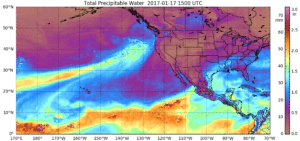
Total precipiatable water measured by water vapor sensors on satellites depicting an atmospheric river from February 2017. Credit: CIMSS
An atmospheric river is a term used to describe a relatively narrow region in the atmosphere that transports water vapor outside of the tropics northward.
They are typically a few thousand miles long and a hundred miles wide. There can be three to five of these “rivers” at any time covering the hemisphere.
Atmospheric rivers are apparent in satellite images and are often in the vicinity of fronts over the oceans. They transport large amounts of water. A common atmospheric river is one that transports water vapor from Hawaii to North America, sometimes nicknamed the “pineapple express.”
While these atmospheric rivers are made of water in the gas form, or water vapor, they can carry as much water as a dozen Mississippi Rivers. The features can transport water into storms and result in extreme precipitation events which cause severe flooding in western coastal regions of the world, including the West Coast of North America.
Much of the precipitation and resulting flooding occurring on the West Coast is from water vapor transported across the Pacific Ocean by these rivers of water vapor. While some of these events lead to flooding and mud slides, most precipitation events simply provide beneficial precipitation important to the region’s water supply.
Much of the water vapor transport to Wisconsin comes from the Gulf of Mexico and not the tropical Pacific Ocean. Water vapor transport by atmospheric river coming from the Pacific Ocean has to flow over the Rocky Mountains, where much of the precipitation falls out.
Steve Ackerman and Jonathan Martin, professors in the UW-Madison department of atmospheric and oceanic sciences, are guests on WHA radio (970 AM) at 11:45 a.m. the last Monday of each month.

